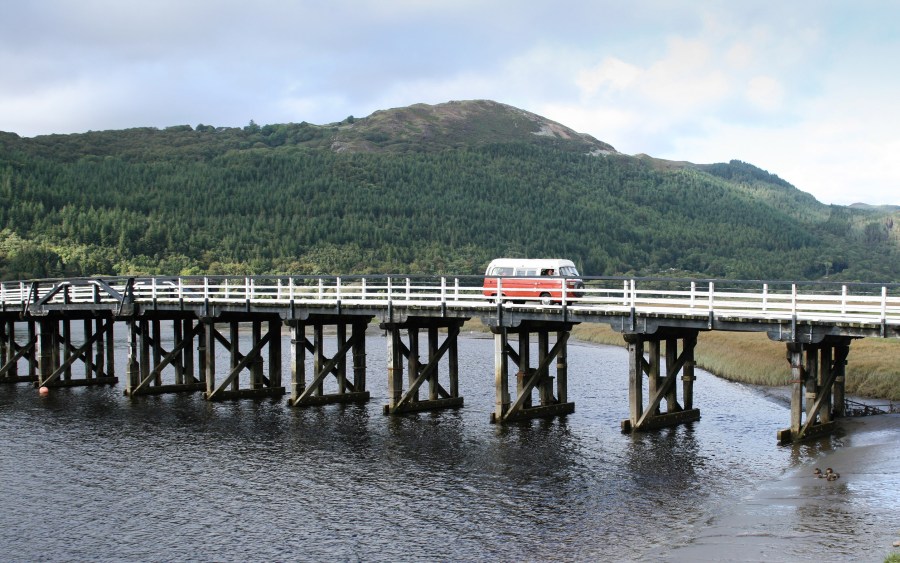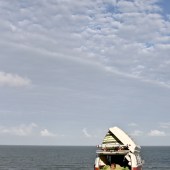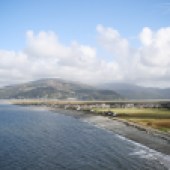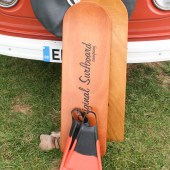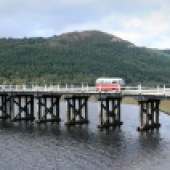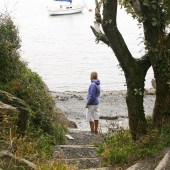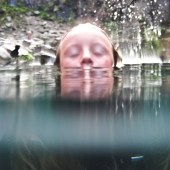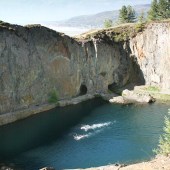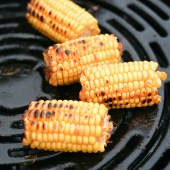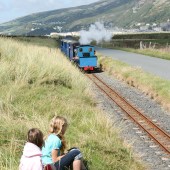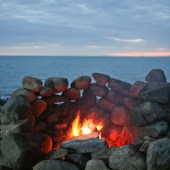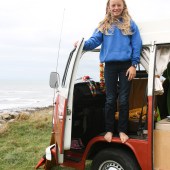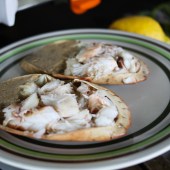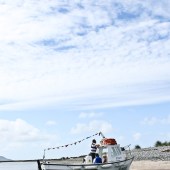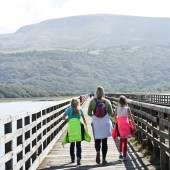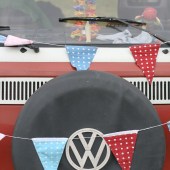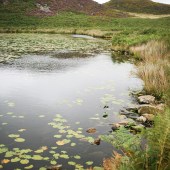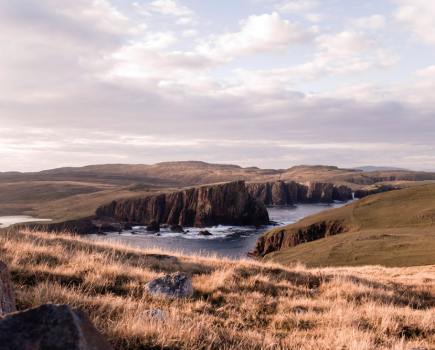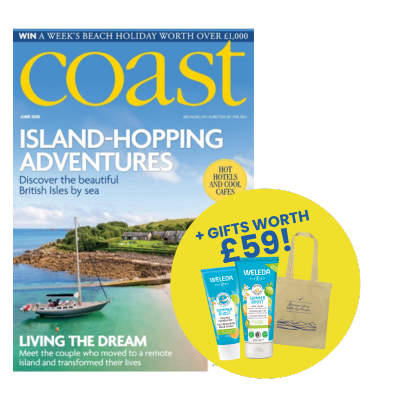Join author and photographer Martin Dorey and family on their lazy journey around the coast of Snowdonia National Park by camper van, steam train, boat and on foot
The secret to good crabbing is to be patient. You just can’t rush these things. Those who don’t wait long enough for the crabs to become really interested in their bag of bait or pull up their line in a hurry rarely land the biggest specimens. They just get left with the tiddlers. And, as we all know, a bucket full of tiddlers counts for nothing when you’ve got a whopper on the line. There’s no comparison.
We hadn’t planned on going crabbing when we chugged into Aberdyfi at the start of a slow journey along the western fringes of Snowdonia National Park, but once we saw the line of excited children peering into the water on the quayside, we couldn’t resist. It had been a long time since we’d even given crabbing a go. So I ducked through the jangling metal fly screen of a fishmonger’s place and came out with a bag of fish tails for a quid, and some dressed crab for our lunch. My kids, Maggie and Charlie, and their mother, Jo, rushed off to buy lines. It would be the last time they had to dash off anywhere on this trip.
We had a journey to complete before the weekend was out, but it didn’t matter whether we dithered, dawdled or meandered as we knew that everything we’d need would always be just a short stroll, chug, pootle or ramble away. In the end we only completed about half of the miles we’d expected to, even though we took trains, boats and bridges and kept moving – albeit at a snail’s pace most of the time.
I’m not one for sitting still, but at the same time I know that, from time to time, it pays to take the slow road. That’s when you see the most. It’s one of the few advantages to travelling by camper van, especially when it’s one of the original German-built ones from the 1970s. Ours might be shiny and well looked after but it couldn’t hurry if it tried. Actually, our camper usually travels with a tail-back all of its own, especially on mountain roads in West Wales.
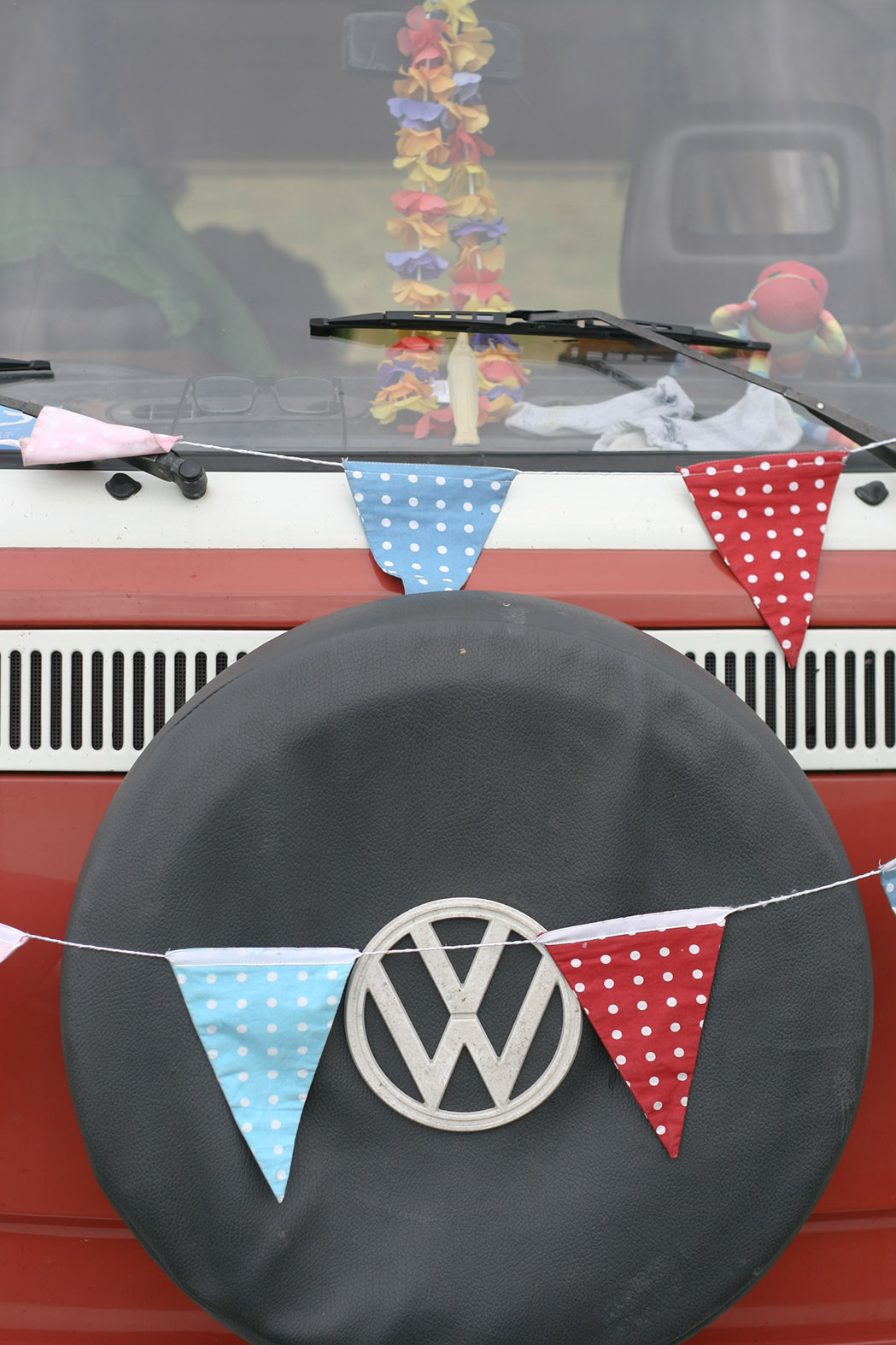
PITCHING CAMP
We arrived at Machynlleth late on Friday night at the end of a storm. Seeking shelter from the wind we found a small Caravan Club-registered site on the banks of the Afon Dyfi east of the town of Aberdyfi. With only five small terraces for campers set around a fishing pond in a steep, lush, green valley and an honesty box for payment, it was definitely our kind of campsite. Overnight the clouds parted and the wind dropped, leaving a sparkling sky full of stars.
The morning brought more cloud but less wind, so we set off for Aberdyfi. This took us along the A493 – the coast road that joins Machynlleth with Dolgellau. Of course there are quicker ways to cover the distance, but that would mean missing out on driving along the Dyfi river to its estuary at Aberdyfi, cruising through Tywyn, skirting the coast beneath the Snowdonia peaks at Fairbourne and, further north, following the Afon Mawddach that empties mountain rains into the sea at Barmouth, to the beautiful and rickety bridge at Penmaenpool.
We didn’t even get as far as Aberdyfi at first. Travelling slowly presents more reasons to stop, so, after a few miles, as the river beside us spread out into the estuary, we spied a path crossing a little bridge over a railway track, and disembarked immediately. We followed it down a set of steps to a small beach of sad, grey slate. Opposite us, the mountains above Borth with their dark wooded slopes lay shrouded in colourless grey mists. The water, reflecting the mood of the sky, was grey as well. But despite the monotones the beach wasn’t without its colour. At the back, leaning against a wall, we found a series of slates etched with pictures, like an outdoor art gallery on the shore. We added our own etchings and set them up among the others to commemorate our moment.
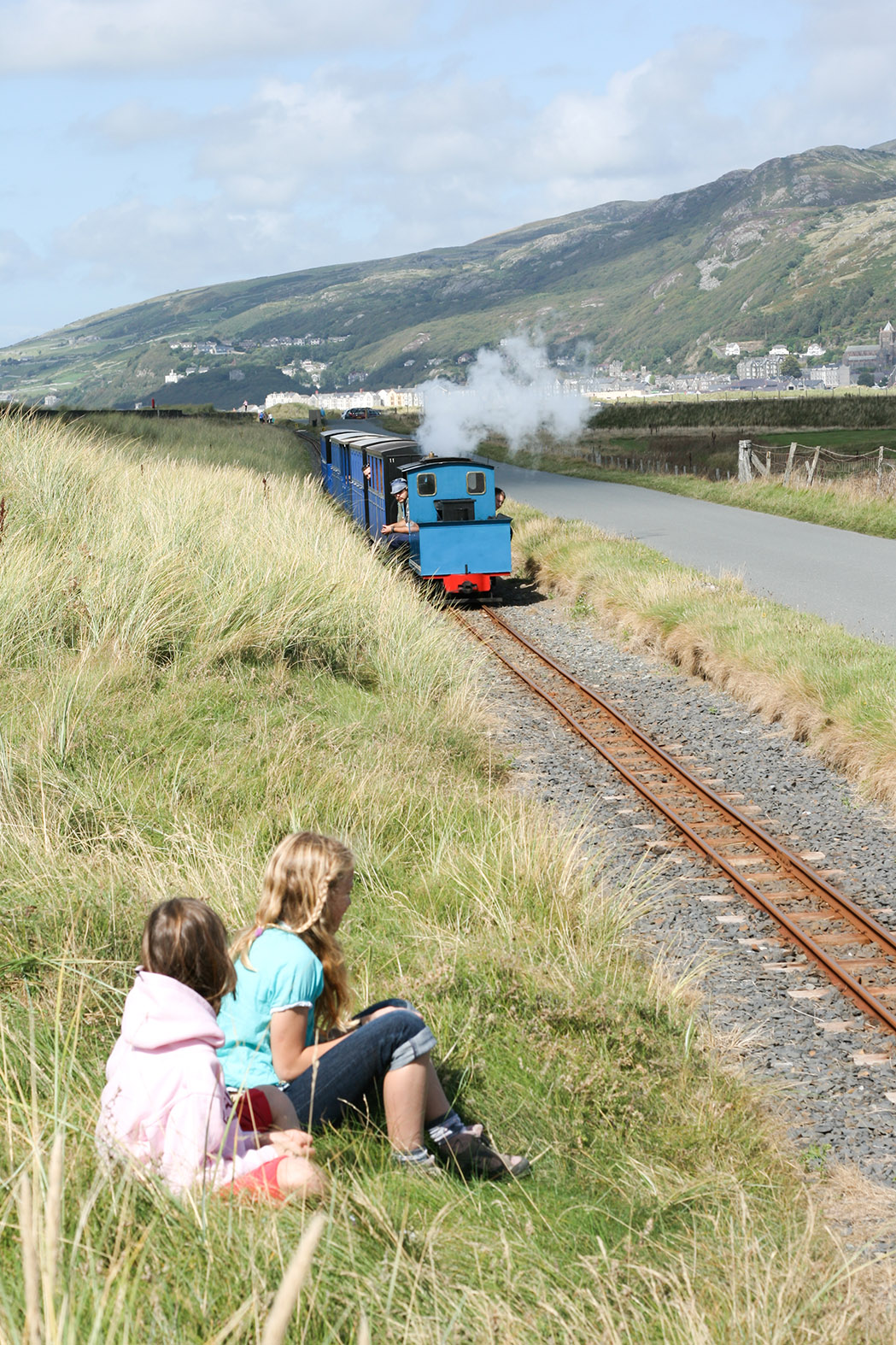
Despite the somewhat gloomy day, Aberdyfi’s brightly painted Victorian houses, sweet shops, ice cream parlours, bobbing boats, antique shops and geranium-filled flower beds all shone like rainbows.
With crabbing completed and lollies licked we sought new adventures. Jo noticed a sign leading through the narrow streets and up into the hills above Aberdyfi to the ‘Bearded Lake’. Intrigued, and beguiled by stories we had heard of dancing fairies, we took the single-track road – which followed the Wales Coast Path – up the steep hillside and into the mountains.
In a few moments we were high above the town, looking down at the estuary and the coast beyond. When the road ended, we put on our walking boots. We were just a few hundred metres from the coast, yet everything had changed. Instead of the grey of sea and sky we found all the natural colours of a fine tweed: the yellows of gorse, the cool greens of lichens and the purples of heather. The lake, though small, was covered with delicate green and yellow lilies. You could easily believe that fairies dance there.
After leaving Aberdyfi, the A493 passes behind the dunes before slipping into and through Tywyn, a sober granite and slate-built Victorian seaside town with a long beach and short – but wide – promenade. We hurried through, eager to do more of nothing much at all at Cae Du, a campsite that has become the darling of the Cool Camping camper. Sitting on a bend in the road and accessible only through a high arched railway bridge, it offers camping right on the cliff edge. Open fires are allowed too. Our girls were more than keen to pile on the logs and open the marshmallows. But not before we’d eaten our wonderful Aberdyfi dressed crab, along with a barbecue of Welsh lamb and caramelised corn on the cob. As the sun went down we toasted marshmallows over the fire. Staring into the embers was better than usual that night. The sea, the sky and the peaks of the Llyn Peninsula in the distance gave us the most wonderful backdrop imaginable. On some evenings, apparently, a pod of dolphins cruises by, but it wasn’t our night for such a spectacle.
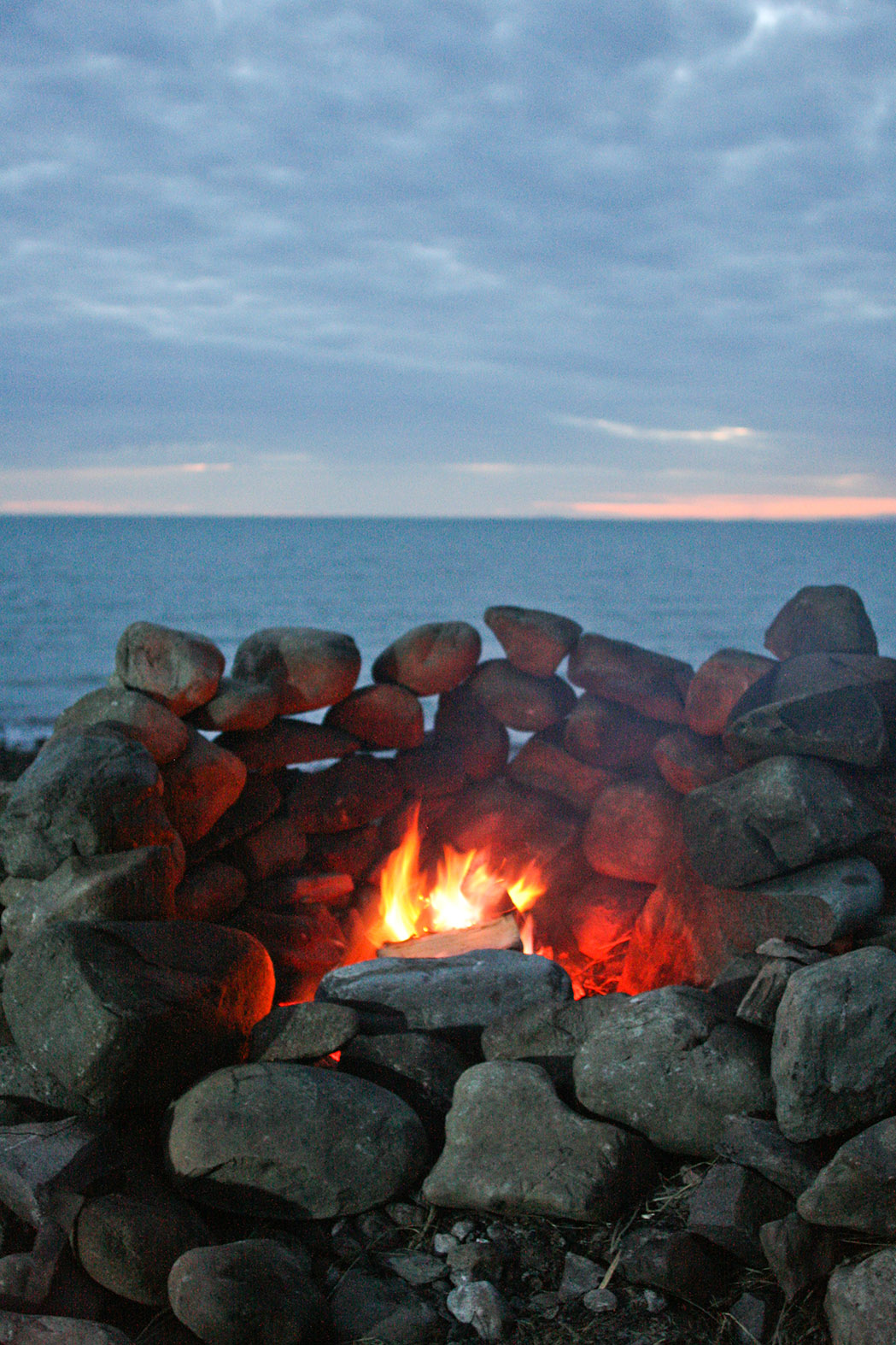
THE ROAD TO BARMOUTH
Morning brought us late summer sunshine and the best part of the journey. From Cae Du the road hugs the side of the mountain as it winds its way past the caravan parks at Llwyngwril to Fairbourne and the Mawddach estuary at Barmouth. You can see it all from the comfort of a camper – especially if you tend to amble a bit – but we wanted to see it from another perspective. Where the road heads up river and away from the coast here, the Fairbourne Narrow Gauge Steam Railway follows the beach to Penrhyn Point at the mouth of the estuary and connects with Barmouth Ferry. From there, a 10-minute boat-ride brings you to Barmouth harbour. It’s a connection that’s been running for hundreds of years. Today, the steam railway is run as a charity so it’s in no hurry at all. It takes around 25 minutes to cover the distance, which is all of two miles. A couple at the ticket office were arguing about the price. ‘You could walk it quicker,’ the husband said. We were pretty sure he’d missed the point as we boarded the tiny carriages and enjoyed being overtaken – yet again – as they strode on towards the ferry.
Barmouth was buzzing. It must have been the sun that brought everybody out. Everywhere we looked we saw people eating chips, enjoying ice creams and fishing for crabs. So we fell into line and found a bench overlooking the river, adjacent to the white sand beach, where we could scoff a seaside lunch from the chipper, stare down the hungry seagulls and watch the world – and his dog – go by. We took the slowest way possible back across the river too – of course – by walking along Barmouth Bridge, a wooden structure that was built in 1867 to carry the Aberystwyth and Welsh Coast Railway. It’s an elegant, if rickety, structure that’s 900 metres long and really more akin to a long pier than a bridge.
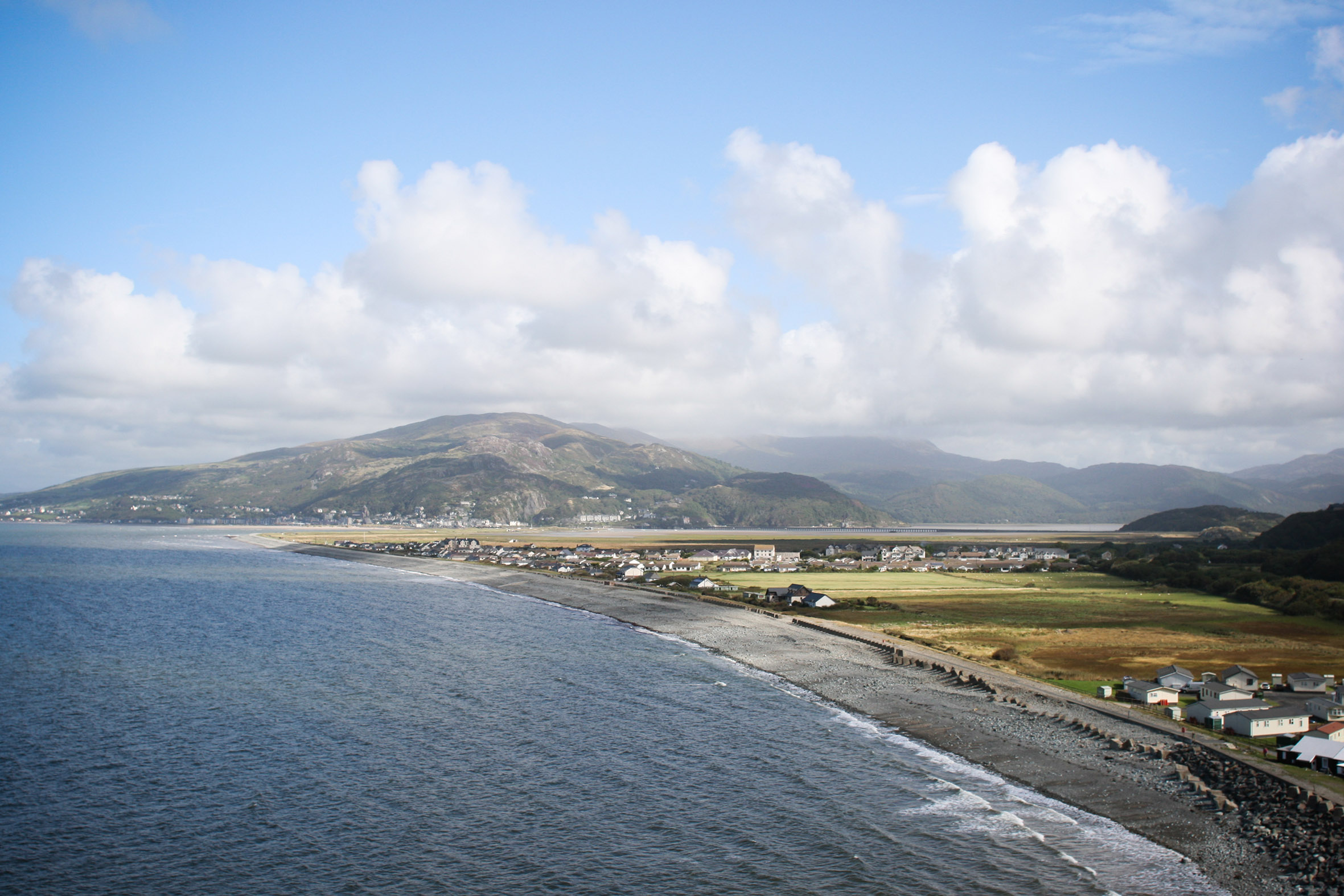
Once back on the Fairbourne side, the path took us past muddy, samphire-laden salt marshes before delivering us neatly back to the railway again, where we waited for a train, as you do, to photograph. More time sitting, enjoying not rushing, just waiting, going nowhere. The signalman high-fived me as they chugged past.
A HIDDEN GEM
We got the shot and moved on to find a hidden gem in the hills above Fairbourne. The Blue Lake is un-signed, un-marked and difficult to find. But it’s worth the search. As soon as you leave the narrow valley that leads away from the main road and you pass through two old slate arches to reach the plateau of the old Goleuwern Slate Quarry, the coast opens up for you. From a perch among the pines we could trace our footsteps in miniature, along the railway, over the river and back across the bridge. The entrance to the lake – a dark and dank, low-ceilinged tunnel – is hidden from view until you get close. Then you have to hop and skip through its flooded floor over slate stepping stones until you reach the light, and the quarry itself. This is the ‘wow’ moment, the big reveal at the end of the road, the El Dorado for wild swimmers like us.
The blue water of the pool looked pretty inviting, so we wasted no time getting into our wetsuits. The water was cold and clean and, despite the clarity, it was impossible to tell its depth. We imagined it to be bottomless, with deep and dark crevices and pits that had seen no light since the last miner had abandoned it to nature. Were there fairies here, or ghosts? It was an effort to remain calm, on the surface, not knowing what lay beneath.
Of course nothing rose from the deep, and we jumped and floated and dived into the silky water until the sun dipped below the steep quarry walls, signalling it was time to go. We ambled back to the coast, down along the steep path, swishing sticks at stingers and feasting on blackberries as we went, taking our time. No point in rushing…
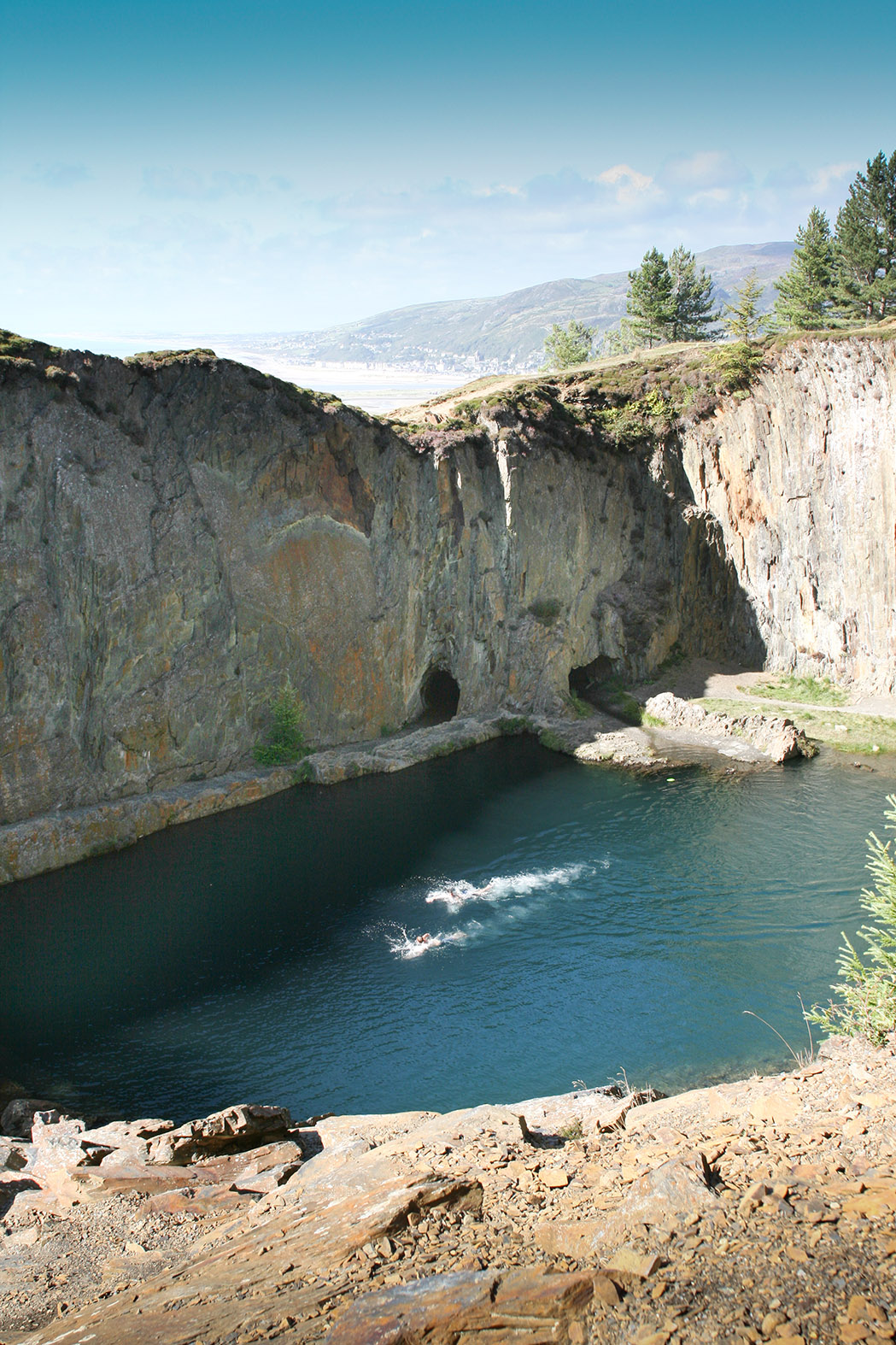
For more seaside activities, click here or pick up a copy of the magazine.
SLOW COASTING: NEED TO KNOW
THE ROUTE: Machynlleth to Barmouth on the A493 is 39 miles long yet includes two river estuaries, mountains, a rickety wooden bridge, sandy beaches, cliffs, dunes, seaside towns and quaint fishing villages. There are harbours, steam trains, hikes, wild swimming spots, cycling trails, water sports, sailing and surfing.
HOW TO TRAVEL:
• By steam train: Fairbourne Narrow Gauge Steam Railway (01341 250362; fairbournerailway.com) Adults £5, children £3, dogs £1.
• By Barmouth Ferry: From Easter onwards the ferry runs with trains. Various operators. Adults and children £3 one way.
• Penmaenpool Bridge: Open daily. The toll for cars is £0.75
• The Mawddach trail: A 15km walking trail from Barmouth to Dolgellau along disused railway lines (mawddachtrail.co.uk).
• Take The Wales Coast Path (walescoastpath.gov.uk).
• The Cambrian Line Railway: This railway hugs the coast from Aberdyfi to Pwllheli on the Llyn Peninsula, offering fantastic views all the way. It begins at Shrewsbury and also goes to Aberystwyth (thecambrianline.co.uk).
CAMPERVAN-FRIENDLY CAMPSITES:
• Cae Du Campsite, Rhosllefain, Tywyn, Gwynedd, LL36 9ND. Open fires, friendly farmer, and amazing location (01654 711 234; Cae Du Farm Facebook page).
Join author and photographer Martin Dorey and family on their lazy journey around the coast of Snowdonia National Park by camper van, steam train, boat and on foot
The secret to good crabbing is to be patient. You just can’t rush these things. Those who don’t wait long enough for the crabs to become really interested in their bag of bait or pull up their line in a hurry rarely land the biggest specimens. They just get left with the tiddlers. And, as we all know, a bucket full of tiddlers counts for nothing when you’ve got a whopper on the line. There’s no comparison.
We hadn’t planned on going crabbing when we chugged into Aberdyfi at the start of a slow journey along the western fringes of Snowdonia National Park, but once we saw the line of excited children peering into the water on the quayside, we couldn’t resist. It had been a long time since we’d even given crabbing a go. So I ducked through the jangling metal fly screen of a fishmonger’s place and came out with a bag of fish tails for a quid, and some dressed crab for our lunch. My kids, Maggie and Charlie, and their mother, Jo, rushed off to buy lines. It would be the last time they had to dash off anywhere on this trip.
We had a journey to complete before the weekend was out, but it didn’t matter whether we dithered, dawdled or meandered as we knew that everything we’d need would always be just a short stroll, chug, pootle or ramble away. In the end we only completed about half of the miles we’d expected to, even though we took trains, boats and bridges and kept moving – albeit at a snail’s pace most of the time.
I’m not one for sitting still, but at the same time I know that, from time to time, it pays to take the slow road. That’s when you see the most. It’s one of the few advantages to travelling by camper van, especially when it’s one of the original German-built ones from the 1970s. Ours might be shiny and well looked after but it couldn’t hurry if it tried. Actually, our camper usually travels with a tail-back all of its own, especially on mountain roads in West Wales.

PITCHING CAMP
We arrived at Machynlleth late on Friday night at the end of a storm. Seeking shelter from the wind we found a small Caravan Club-registered site on the banks of the Afon Dyfi east of the town of Aberdyfi. With only five small terraces for campers set around a fishing pond in a steep, lush, green valley and an honesty box for payment, it was definitely our kind of campsite. Overnight the clouds parted and the wind dropped, leaving a sparkling sky full of stars.
The morning brought more cloud but less wind, so we set off for Aberdyfi. This took us along the A493 – the coast road that joins Machynlleth with Dolgellau. Of course there are quicker ways to cover the distance, but that would mean missing out on driving along the Dyfi river to its estuary at Aberdyfi, cruising through Tywyn, skirting the coast beneath the Snowdonia peaks at Fairbourne and, further north, following the Afon Mawddach that empties mountain rains into the sea at Barmouth, to the beautiful and rickety bridge at Penmaenpool.
We didn’t even get as far as Aberdyfi at first. Travelling slowly presents more reasons to stop, so, after a few miles, as the river beside us spread out into the estuary, we spied a path crossing a little bridge over a railway track, and disembarked immediately. We followed it down a set of steps to a small beach of sad, grey slate. Opposite us, the mountains above Borth with their dark wooded slopes lay shrouded in colourless grey mists. The water, reflecting the mood of the sky, was grey as well. But despite the monotones the beach wasn’t without its colour. At the back, leaning against a wall, we found a series of slates etched with pictures, like an outdoor art gallery on the shore. We added our own etchings and set them up among the others to commemorate our moment.

Despite the somewhat gloomy day, Aberdyfi’s brightly painted Victorian houses, sweet shops, ice cream parlours, bobbing boats, antique shops and geranium-filled flower beds all shone like rainbows.
With crabbing completed and lollies licked we sought new adventures. Jo noticed a sign leading through the narrow streets and up into the hills above Aberdyfi to the ‘Bearded Lake’. Intrigued, and beguiled by stories we had heard of dancing fairies, we took the single-track road – which followed the Wales Coast Path – up the steep hillside and into the mountains.
In a few moments we were high above the town, looking down at the estuary and the coast beyond. When the road ended, we put on our walking boots. We were just a few hundred metres from the coast, yet everything had changed. Instead of the grey of sea and sky we found all the natural colours of a fine tweed: the yellows of gorse, the cool greens of lichens and the purples of heather. The lake, though small, was covered with delicate green and yellow lilies. You could easily believe that fairies dance there.
After leaving Aberdyfi, the A493 passes behind the dunes before slipping into and through Tywyn, a sober granite and slate-built Victorian seaside town with a long beach and short – but wide – promenade. We hurried through, eager to do more of nothing much at all at Cae Du, a campsite that has become the darling of the Cool Camping camper. Sitting on a bend in the road and accessible only through a high arched railway bridge, it offers camping right on the cliff edge. Open fires are allowed too. Our girls were more than keen to pile on the logs and open the marshmallows. But not before we’d eaten our wonderful Aberdyfi dressed crab, along with a barbecue of Welsh lamb and caramelised corn on the cob. As the sun went down we toasted marshmallows over the fire. Staring into the embers was better than usual that night. The sea, the sky and the peaks of the Llyn Peninsula in the distance gave us the most wonderful backdrop imaginable. On some evenings, apparently, a pod of dolphins cruises by, but it wasn’t our night for such a spectacle.

THE ROAD TO BARMOUTH
Morning brought us late summer sunshine and the best part of the journey. From Cae Du the road hugs the side of the mountain as it winds its way past the caravan parks at Llwyngwril to Fairbourne and the Mawddach estuary at Barmouth. You can see it all from the comfort of a camper – especially if you tend to amble a bit – but we wanted to see it from another perspective. Where the road heads up river and away from the coast here, the Fairbourne Narrow Gauge Steam Railway follows the beach to Penrhyn Point at the mouth of the estuary and connects with Barmouth Ferry. From there, a 10-minute boat-ride brings you to Barmouth harbour. It’s a connection that’s been running for hundreds of years. Today, the steam railway is run as a charity so it’s in no hurry at all. It takes around 25 minutes to cover the distance, which is all of two miles. A couple at the ticket office were arguing about the price. ‘You could walk it quicker,’ the husband said. We were pretty sure he’d missed the point as we boarded the tiny carriages and enjoyed being overtaken – yet again – as they strode on towards the ferry.
Barmouth was buzzing. It must have been the sun that brought everybody out. Everywhere we looked we saw people eating chips, enjoying ice creams and fishing for crabs. So we fell into line and found a bench overlooking the river, adjacent to the white sand beach, where we could scoff a seaside lunch from the chipper, stare down the hungry seagulls and watch the world – and his dog – go by. We took the slowest way possible back across the river too – of course – by walking along Barmouth Bridge, a wooden structure that was built in 1867 to carry the Aberystwyth and Welsh Coast Railway. It’s an elegant, if rickety, structure that’s 900 metres long and really more akin to a long pier than a bridge.

Once back on the Fairbourne side, the path took us past muddy, samphire-laden salt marshes before delivering us neatly back to the railway again, where we waited for a train, as you do, to photograph. More time sitting, enjoying not rushing, just waiting, going nowhere. The signalman high-fived me as they chugged past.
A HIDDEN GEM
We got the shot and moved on to find a hidden gem in the hills above Fairbourne. The Blue Lake is un-signed, un-marked and difficult to find. But it’s worth the search. As soon as you leave the narrow valley that leads away from the main road and you pass through two old slate arches to reach the plateau of the old Goleuwern Slate Quarry, the coast opens up for you. From a perch among the pines we could trace our footsteps in miniature, along the railway, over the river and back across the bridge. The entrance to the lake – a dark and dank, low-ceilinged tunnel – is hidden from view until you get close. Then you have to hop and skip through its flooded floor over slate stepping stones until you reach the light, and the quarry itself. This is the ‘wow’ moment, the big reveal at the end of the road, the El Dorado for wild swimmers like us.
The blue water of the pool looked pretty inviting, so we wasted no time getting into our wetsuits. The water was cold and clean and, despite the clarity, it was impossible to tell its depth. We imagined it to be bottomless, with deep and dark crevices and pits that had seen no light since the last miner had abandoned it to nature. Were there fairies here, or ghosts? It was an effort to remain calm, on the surface, not knowing what lay beneath.
Of course nothing rose from the deep, and we jumped and floated and dived into the silky water until the sun dipped below the steep quarry walls, signalling it was time to go. We ambled back to the coast, down along the steep path, swishing sticks at stingers and feasting on blackberries as we went, taking our time. No point in rushing…

For more seaside activities, click here or pick up a copy of the magazine.
SLOW COASTING: NEED TO KNOW
THE ROUTE: Machynlleth to Barmouth on the A493 is 39 miles long yet includes two river estuaries, mountains, a rickety wooden bridge, sandy beaches, cliffs, dunes, seaside towns and quaint fishing villages. There are harbours, steam trains, hikes, wild swimming spots, cycling trails, water sports, sailing and surfing.
HOW TO TRAVEL:
• By steam train: Fairbourne Narrow Gauge Steam Railway (01341 250362; fairbournerailway.com) Adults £5, children £3, dogs £1.
• By Barmouth Ferry: From Easter onwards the ferry runs with trains. Various operators. Adults and children £3 one way.
• Penmaenpool Bridge: Open daily. The toll for cars is £0.75
• The Mawddach trail: A 15km walking trail from Barmouth to Dolgellau along disused railway lines (mawddachtrail.co.uk).
• Take The Wales Coast Path (walescoastpath.gov.uk).
• The Cambrian Line Railway: This railway hugs the coast from Aberdyfi to Pwllheli on the Llyn Peninsula, offering fantastic views all the way. It begins at Shrewsbury and also goes to Aberystwyth (thecambrianline.co.uk).
CAMPERVAN-FRIENDLY CAMPSITES:
• Cae Du Campsite, Rhosllefain, Tywyn, Gwynedd, LL36 9ND. Open fires, friendly farmer, and amazing location (01654 711 234; Cae Du Farm Facebook page).

